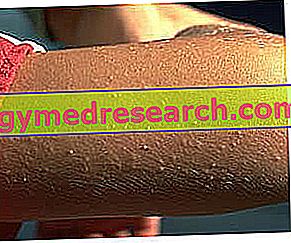What is that
Follicular keratosis is a dermatological disease that creates alterations in the keratinization of hair follicles.

"Follicular keratoses" and "pilate keratoses" are synonymous and indicate a condition of hyperkeratosis, that is to say an abnormal thickening of the stratum corneum of the epidermis: in this article we will first examine a rare variant of the disorder - called Siemens spinulosic follicular keratosis - then, the reverse follicular keratosis will be examined briefly and, finally, the connection between follicular keratosis and Darier disease will be briefly analyzed.
Follicular Keratosis Spinulosa Setting by Siemens
The decalvating follicular keratosis of Siemens is a rare variant of keratosis that occurs in different parts of the body. In detail, Siemens decalvenous follicular keratosis belongs to the group of skin diseases defined as rare genodermatoses.
Transmission
The decalvant follicular keratosis is genetically transmitted as a recessive trait linked to the X chromosome: for this reason, affected women are generally healthy carriers (it is the same concept that we analyzed in color blindness). This theory of genetic transmission, however, has been questioned by some recent research: it seems, in fact, that the follicular keratosis of Siemens, in some subjects, is transmitted as an autosomal dominant trait; consequently the disease can manifest itself in both men and women with the same probability.
Signs and Symptoms
Follicular keratosis begins at puberty with the formation of keratotic papules in the follicles: it is a disease that affects the skin, eyes and hair follicles at the level of ears, palms of the hands, soles of the feet, neck and face. The affected areas have a progressive loss of eyelashes and eyebrows, beard and hair (for this reason, follicular keratosis is often associated with generalized alopecia). Even the eyelids are injured, as they become thicker; at the ocular level, there is also a degeneration - slow but progressive - of the cornea.
Other symptoms associated with this form of follicular keratosis are represented by: photophobia, facial erythema, inflammation on the face caused by bacterial infections, atopy and palmo-plantar keratoderma.
Treatment
Unfortunately, Science has not yet found the proper cure for the complete resolution of the disorder: it is certain, however, that the signs left by Siemens follicular keratosis can be alleviated and kept under control by applying corticosteroid based ointments. Furthermore, in some cases, but not in all, the condition responds positively to therapy with systemic retinoids.
In the event that follicular keratosis was also accompanied by bacterial infections and inflammatory wounds, the use of antibiotics is recommended, obviously with a medical prescription.
However, before undergoing any therapy, the biopsy of the affected skin tissue, of medical competence, is essential to ascertain Siemens decalvating follicular keratosis.
Reverse Follicular Keratosis
This disease is also known as "irritated seborrheic keratosis": it is a rare disorder that affects the face. It is called "seborrheic" due to the histological features it presents, related to seborrheic keratosis. In reverse follicular keratosis, however, there are also squamous areas arranged in a vortex, which progressively extend over the surface of the epidermis. It manifests itself with papillomas at the level of the eyelid: they are not pigmented and can develop in more serious forms, so as to prevent a correct vision to the subject.
The only possible treatment for curing inverted follicular keratosis is the surgical removal of papilloma.
Darier disease
Relationship between follicular keratosis and Darier disease
Follicular keratoses are also found in Darier's disease, an autosomal dominant cutaneous disorder of interest manifested by fat, yellow or brown keratotic papules. Darier disease is also known as "follicular keratosis or Darier-White disease" and also belongs to the group of rare genodermatoses.
This form of follicular keratosis occurs mainly in the seborrheic areas of the face and trunk and, more particularly, its manifestations involve the forehead, scalp, ears, neck, back and upper part of the chest.
Darier's disease refers to follicular keratosis because it causes bullous papules similar to those that occur in keratosis: in this regard, both cutaneous manifestations are considered variants of verruciform rash (rare form of dermatosis).
However, given the particular characteristics of the papules with which the pathology manifests itself, Darier's disease could be misinterpreted as seborrheic dermatitis.
Signs and Symptoms
As mentioned, Darier's disease is characterized by the formation of fatty, yellow or brown keratotic papules, which are associated with characteristic nail changes.
The papules can join to the point of forming real plaques, decidedly unaesthetic. These lesions can become irritated and become infected, becoming smelly and therefore a major problem for the patient. The nails, on the other hand, are fragile and possess a characteristic and abnormal "V shape".
Moreover, on the backs of hands and feet there are dotted keratoses which represent a typical sign of this pathology.
The symptomatology of Darier disease can be worsened by exposure to sunlight or artificial UVB rays, just as it can be negatively affected by heat or sweating.
Treatment
Isotretinoin treatment can be useful to counteract the typical hyperkeratosis associated with this disease, as well as products based on lactic acid or urea. The use of topical corticosteroids, on the other hand, can help counteract irritation. In severe cases, the doctor may also prescribe the administration of oral retinoids.
As an alternative to drug treatment, surgical measures, laser removal and dermabrasion can be used to eliminate bullous papules typical of Darier disease and follicular keratosis.



